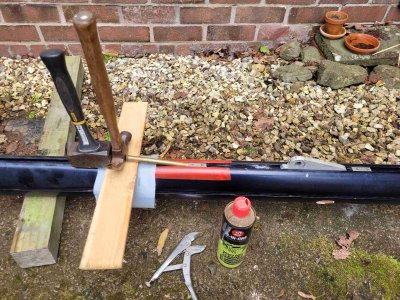Mark in Portishead
New member
Hi everyone. Yesterday I was going to post a question on how to remove stubborn fittings from a boom but today I solved the problem so am instead sharing how I succeeded and what I learnt in the process.
The previous owner had fitted stainless steel inserts as stops either side of the vang fitting in the boom T-track. Galvanic corrosion had caused these to be VERY firmly seized in the track. I tried the usual suggested techniques of gentle heat and penetrating fluid but without success. I finally succeeded, with a friend, with the set-up in the photograph. Here, I am showing how I removed the final stop. I used a brass drift with a rounded end, so as not to score the boom, and at as shallow an angle as possible. I placed a claw hammer sideways on against the drift to provide a better, easier-to-hit target. I hit that target with significant energy with a 1.25 kg club hammer. It took about half a dozen blows to move it its own length, after which it was free. My friend kept the brass drift in position with mole grips.
What have I learnt? I applied a lot of various types of penetrating fluid - the last type citric acid based - but I am dubious about whether they were in any way influential. I tried a similar set up with a pneumatic hammer but with no success and think I could get more force with the manual set up below. Many people recommend heat cycles but I doubt this would have been effective. The fitting was not 'bonded in' by the corrosion - the aluminium oxide has minimal strength. Rather it is, in my opinion, just that the volume of aluminium oxide produces pressure and high interference i.e. high friction and heat cycles would have no effect on this. Finally - and this is key - the tendency is to hit too gently, for fear of damaging something, but you really need to put all your might into the hammer strike to get results. You can see in the photograph the measures I took to try and protect the boom and hence have confidence to strike with all my might. In the end, this was successful. And last of all, don't ever put stainless steel in contact with aluminium, even if it's anodised, or corrosion is sure to result.
The previous owner had fitted stainless steel inserts as stops either side of the vang fitting in the boom T-track. Galvanic corrosion had caused these to be VERY firmly seized in the track. I tried the usual suggested techniques of gentle heat and penetrating fluid but without success. I finally succeeded, with a friend, with the set-up in the photograph. Here, I am showing how I removed the final stop. I used a brass drift with a rounded end, so as not to score the boom, and at as shallow an angle as possible. I placed a claw hammer sideways on against the drift to provide a better, easier-to-hit target. I hit that target with significant energy with a 1.25 kg club hammer. It took about half a dozen blows to move it its own length, after which it was free. My friend kept the brass drift in position with mole grips.
What have I learnt? I applied a lot of various types of penetrating fluid - the last type citric acid based - but I am dubious about whether they were in any way influential. I tried a similar set up with a pneumatic hammer but with no success and think I could get more force with the manual set up below. Many people recommend heat cycles but I doubt this would have been effective. The fitting was not 'bonded in' by the corrosion - the aluminium oxide has minimal strength. Rather it is, in my opinion, just that the volume of aluminium oxide produces pressure and high interference i.e. high friction and heat cycles would have no effect on this. Finally - and this is key - the tendency is to hit too gently, for fear of damaging something, but you really need to put all your might into the hammer strike to get results. You can see in the photograph the measures I took to try and protect the boom and hence have confidence to strike with all my might. In the end, this was successful. And last of all, don't ever put stainless steel in contact with aluminium, even if it's anodised, or corrosion is sure to result.

